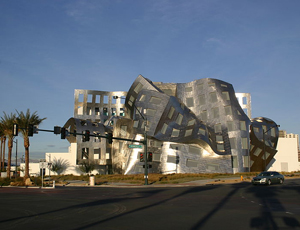With the Smith Center for the Performing Arts in Las Vegas, David Schwarz brings an earnest take on a historical style to the capital of pastiche.
The Smith Center for the Performing Arts by David M. Schwarz Architects |

These days, Las Vegas is best known for its themed casinos (Luxor, Paris, New York, New York) and their intentionally cartoonish buildings. Architects tend to be appalled.
In that context, it’s easy to dismiss the Smith Center for the Performing Arts as another ersatz vision for Las Vegas. Unlike the sleekly modern concert halls of cities where everything is up to date, like Kansas City, it is an art deco confection—a throwback to the 1930s (think Rockefeller Center and Los Angeles’ Union Station). That means some critics will question its architectural bona fides.
Just for the record, this is not a postmodernist building. Its architect, David Schwarz, a Yale alumnus (and sometimes teacher) is well aware of the connections between Las Vegas, the Venturis, and postmodernism. But his architecture is not about irony, via the application of mis-scaled period details; it is entirely in earnest. And if that guarantees critical disdain, Schwarz (whose firm, David M. Schwarz Architects, has designed numerous “retro” buildings) is ready.
“The clients wanted a building that would be timeless,” he says. “And they wanted a building that would be taken seriously. Those are potentially contradictory instructions.” His goal, he continues, is not that the building make the cover of architecture magazines, but that it make the cover of the local phone book—a sign that the public has embraced it.
The Smith Center, which cost $245 million, is the result of civic ambitions and need: the big hotels on the Strip are outside the city limits, depriving Las Vegas of its “rightful” tax base. To boost its languishing downtown, the city designated 61 acres—a former rail yard—for development, with the Smith Center expected to be the focus of the new neighborhood, Symphony Park. The economy being what it is, nothing has been built except the Center, which contains a 2,050-seat main hall, several smaller performance venues, and a children’s museum, and which will open to the public next month. It was paid for with a mix of pubic and private funds, including a special tax on car rentals and donations from casino operators—while casinos may ply high rollers with tickets, Smith Center programs are marketed primarily to locals.
Schwarz, based in Washington, D.C., says the first question he asks every new client is, “How long do you want the building to last?” The Smith Center board told him 100 years. That, to him, meant making the building that is durably not only physically, but stylistically. Indeed, he believes the deco detailing will stand the test of time. For proof, he points to Hoover Dam. That Depression-era masterpiece, which Schwarz correctly calls the best building for hundreds of miles around, and probably the most significant building in the history of Las Vegas, is in a muscular art deco style that looks as good today as it did in 1936.
But does that style work for a 21st century concert hall? The Smith Center is a technological marvel—the acoustics in the main room have already won raves. (The acoustical consultant, Paul Scarborough of Akustiks, was hired even before Schwarz; his scheme blends two traditional forms: the shoebox concert hall and horseshoe opera house). And the machinery that allows the theater to morph from opera house to concert hall to “Broadway” theater is awe-inspiring.
As for the building’s style: there are many lovely evocations of art deco. But this is no Hoover Dam. There, the emphasis is on heroic forms. The Smith Center is nicely massed—it culminates in a 170-foot-high carillon tower. But its details tend to lack self-confidence, sometimes lapsing into art nouveau and craftsman styles. There are numerous depictions of irises, the favorite flower of one of the donors. Schwarz says his firm is process-oriented, not product oriented, meaning it is willing to go where its research—and its clients—lead it.
Urbanistically, the building is a question mark, since so little has been built around it. A large parking garage, demanded by the children’s museum, gives its southern edge an awkward, unfinished look, at odds with the balance Schwarz hoped to achieve. At the main entrance, a small park is meant to link the Smith Center to the community. But mostly, there is sand.
Anyone who wants to draw a line between “real” and “fake” architecture has to look a few hundred yards south to the Lou Ruvo Center for Brain Health. Ruvo cloaks a rather ordinary medical clinic in a riot of curving, angled stainless steel panels—a Frank Gehry-designed fillip that helped attract donors and media attention, but added nothing to the building’s functionality. By almost any measure, Ruvo is more “fake” than the Smith Center.
As the Smith Center debuts, Schwarz is turning to another Las Vegas project. This time the client is Caesars, the gaming company that controls nearly 400 acres along the Strip. Some of those acres will become an outdoor shopping mall, designed by Schwarz. There, hard by the “Colosseum” and a half-scale Eiffel Tower, no one will ask if the architecture is “real.”
Does the Smith Center deserve any less?























Post a comment to this article
Report Abusive Comment